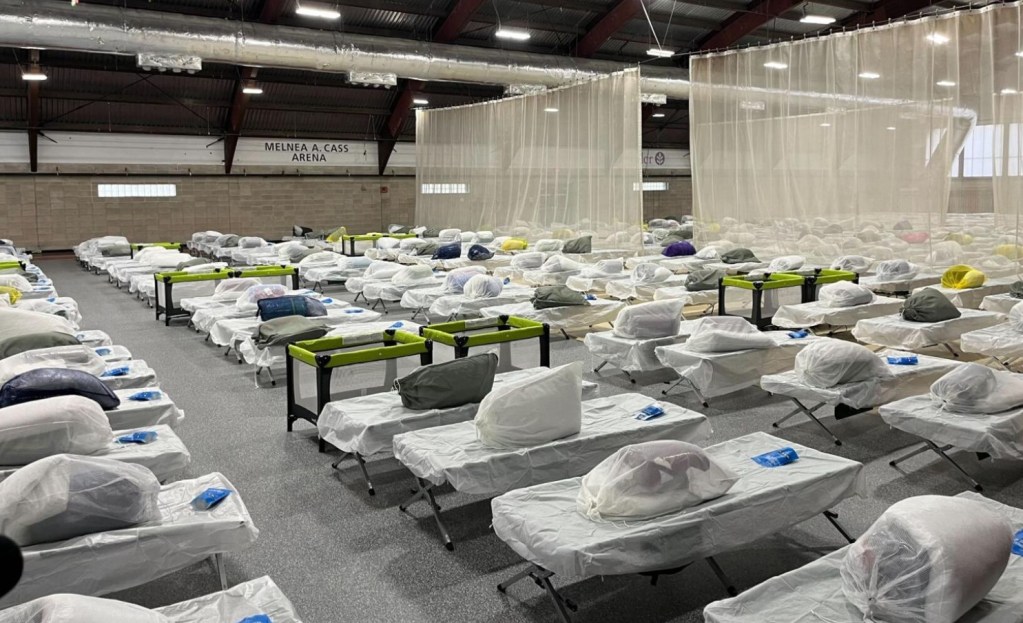State housing officials released guidance Wednesday about the implementation of new limits on how long families may stay in emergency shelters, with the first families scheduled to be kicked out of the system as early as Sept. 29.
As previously reported by the State House News Service, families who have been in state shelter for longer than nine months could begin receiving notices by early July that they have 90 days to leave and find other housing accommodations.
About 4,000 of the 7,500 families in the system have been living in shelters for more than nine months, according to the Executive Office of Housing and Livable Communities (EOHLC).
The guidance outlines a rolling start for these notices – so not every family whose stay is longer than nine months will be affected immediately. A new law agreed to this year by the Legislature and Gov. Maura Healey put a limit on how long families can stay in shelter, and it also said no more than 150 families should be removed by the state every week, not counting families who leave on their own.
According to the implementation plans, the executive office will give 90-day notices to no more than 150 families for the full month of July, though they may increase the pace of removals in subsequent months.
Every family that has been in shelter for longer than nine months will receive one of three notices in July: informing them they need to leave soon but are eligible for a 90-day extension and providing them with a termination date; letting them know they are not eligible for that 90-day extension and giving the date by which they will have to leave; or informing a family that they have not been selected to leave this month, but may be selected soon.
Of the 4,000 families who are over the nine-month limit, EOHLC will choose which 150 to send the first removal notices to based on which families they believe are the best positioned to succeed out of the shelters, officials said Wednesday.
They will also make location-based decisions aiming to not overwhelm certain regions of the state by removing dozens of families from shelter in the same area at once, officials said.
About half of the occupants of the family shelter system are migrants who recently arrived in the U.S. EOHLC will not factor a family’s immigration status into their determinations of who to send more immediate notices of removal to, they said.
The guidance also spells out eligibility criteria for the two 90-day extensions that families may apply for, as well as the details of “hardship waivers.”
Lawmakers built into the new law language for families in difficult circumstances to apply for hardship waivers to stay in shelter longer, with approval from EOHLC. Though, like many details of the time limits, they left the details up to the administration to draft in their regulations.
The guidance released Wednesday says that a family who has exhausted both 90-day extensions may apply for an additional extension of up to 120 days in particular circumstances.
To qualify for this hardship waiver, a family must be in compliance with a rehousing assessment and meet certain criteria, including having: a baby aged 0 to 3 months, a family member with an immunocompromised condition, a high-risk pregnancy, a family member with a medical device, or risk of imminent harm due to child protection or domestic violence concerns.
The guidance also outlines an appeal process, and makes clear that families who leave an emergency shelter unit on or before their termination day can re-apply for shelter immediately, though they would be subject to the same waitlist and prioritization process as every other new applicant.
The waitlist is currently at around 800 families hoping to get a spot in shelter.
The Healey administration previously said that families could begin receiving 90-day notices to exit on June 1, before they backtracked to an early July start date, as previously reported by the News Service.
By starting the 90-day clock this summer, EOHLC is applying the law legislators and Healey approved this spring retroactively to the start of 2024, instead of beginning to count nine months from when the law was passed or notices are sent out.
Providers have objected to this interpretation, saying it doesn’t give families and providers enough time to find other accommodations for homeless families.
Asked by reporters Wednesday if the guidelines released by the administration, under which families could be forced to leave shelters by late-September, were what they intended with the time limit law, House Speaker Ron Mariano said lawmakers wanted to give Healey and EOHLC options in writing the regulations.
“We knew this was gonna come to a head, there was no inclination to us that this was going to stop. And eventually these shelters are all going to be filled, and we had to take action,” Mariano said. “We outlined a plan we felt was responsible. We gave them some opportunities, and we put enough opportunities for folks to appeal and get a stay of removal. So we think that the bill is fair.”
He added, “It’ll deal with the people who are in very difficult stressful situations who can’t leave, but by the same token, it will start the migration out of shelters.”
The post New guidance offers key details of family shelter limits appeared first on CommonWealth Beacon.

